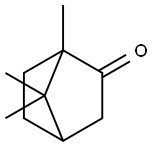76-22-2

Product Name:
Camphor
Formula:
C10H16O
Synonyms:
2-Bornanone;2-Camphanone;(±)-Camphor;(1S)-1,7,7-Trimethylbicyclo[2.2.1]heptan-2-one;D -Camphor
Inquiry
SAFETY INFORMATION
| Signal word | Danger |
|---|---|
| Pictogram(s) |
 Flame Flammables GHS02  Corrosion Corrosives GHS05  Exclamation Mark Irritant GHS07  Health Hazard GHS08  Environment GHS09 |
| GHS Hazard Statements |
H228:Flammable solids H315:Skin corrosion/irritation H317:Sensitisation, Skin H318:Serious eye damage/eye irritation H332:Acute toxicity,inhalation H371:Specific target organ toxicity, single exposure H411:Hazardous to the aquatic environment, long-term hazard |
| Precautionary Statement Codes |
P210:Keep away from heat/sparks/open flames/hot surfaces. — No smoking. P273:Avoid release to the environment. P280:Wear protective gloves/protective clothing/eye protection/face protection. P305+P351+P338:IF IN EYES: Rinse cautiously with water for several minutes. Remove contact lenses, if present and easy to do. Continuerinsing. |
PRODUCT INTRODUCTION
Description
Camphor is an aromatic terpene ketone that used to be made by distilling the bark and wood of the camphor tree. Today, camphor is usually synthesized from turpentine oil. It's a common ingredient in remedies applied to the skin for cough and skin irritation.
